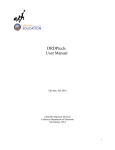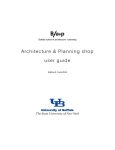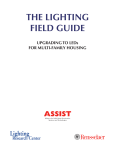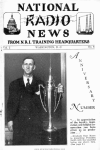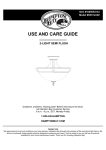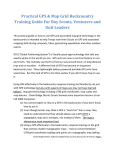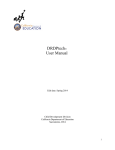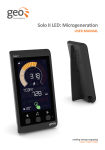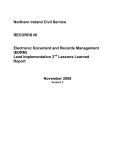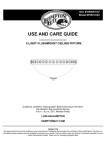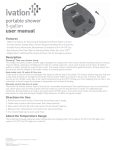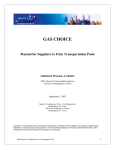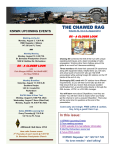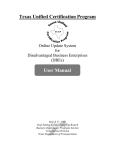Download BEC Lighting the Way - Bandera Electric Cooperative
Transcript
Co-op News BANDERA ELECTRIC COOPERATIVE BEC Lighting the Way MESSAGE FROM GENERAL MANAGER BILL HETHERINGTON WITH THE PASSAGE OF THE METROPOLITAN GAS Act of 1860, London became the first city to have designated gas lighting districts. In order to establish a reference for comparing light energy in the new lighting districts, the term candlepower was coined. Candlepower, as defined by EncyclopediaBritannica.com, “is the light given off by a candle of pure spermaceti burning at a rate of 7.776 grams (120 grains) per hour.” Spermaceti, a natural substance found in the heads of sperm whales, was once used to make high-quality candles. For nearly 50 years, candlepower was a standard measure of luminous output for bulbs. Edison also used candlepower for rating his generators. However, around 1910 the term was abandoned for watts as the rating system for light bulbs. At that time, other than electric lights, there were very few electrical appliances in most homes, and light sockets and other equipment were also rated in candlepower rather than watts. This provided a rather simple method of comparison since the only devices anyone would generally power were 8CP or 16CP lamps. If you are living in an older home that was built in the early 1900s, you may have some candlepower rated sockets. One way to identify these light sockets is to check for an imprint that says “50CP” rather than “250W.” As the 1930s rolled around, electric utilities had begun installing watt-hour meters in homes and residential lighting was measured in watts of power rather than the amount of light. Electric Engineer Steve O’Bannon of Rexophone.com, notes that electric utilities generally recommended a 40-watt lamp for the living room and a 20-watt light for hallways. Many electrical utilities provided lamps for their customers. Indeed, some early electrical utilities did not sell bulbs at all, customers simply brought in burned out bulbs for a replacement. This tradition persisted in some Texas utilities well into the 1990s. Because early electric utilities generally powered lights only, many customers referred to their bill as the “light bill.” Now, with the development of light emitting diode lights for use in homes, and their superior performance in Source: U.S. Department of Energy energy efficiency, we have come full circle. With the arrival of LED lights on the market, we are back to measuring the amount of light emitted rather than power to the light. However, instead of candlepower, light is now measured in lumens. To help consumers better understand the switch from watts to lumens, the U.S. Department of Energy has developed new product labels for light bulbs. Like the helpful nutrition label on food products, the lighting facts label helps consumers understand what they are really purchasing. The label clearly provides the lumens—or brightness—of the bulb, the estimated operating cost for the year, and the color of the light from warm/yellowish, to white, to cool/blue. The DOE has more information about LED lights at lightingfacts.com. While BEC no longer offers replacement light bulbs, we are providing our members with the energy information and options to reduce their “light” bill. Bandera Electric Town Hall Meetings Comfort June 25, 6 p.m. Immanuel Lutheran Church 318 High St. 18 Texas Co-op Power BanderaEC_2015_June_Final.indd 18 BANDERA EC June 2015 Utopia July 23, 6 p.m. Sabinal Canyon Senior Center 1037 N. Main St. Leakey September 24, 6 p.m. Leakey ISD Cafeteria 429 U.S. Hwy. 83 N. BanderaElectric.com 5/12/2015 4:53:50 PM 1-866-226-3372 | BANDERAELECTRIC.COM Operation Round Up Bandera Electric Cooperative, Inc. 3172 Highway 16 N. • P.O. Box 667 Bandera, TX 78003 1-866-226-3372 (1-866-BANDERA) BanderaElectric.com Operating in Bandera, Bexar, Kendall, Kerr, Medina, Real and Uvalde counties G E NE RA L M A NA G E R William “Bill” Hetherington BO A RD O F D IRE CTO RS Michael D.T. Edwards, President Douglas R. “Rob” Sandidge, Vice President Kurt Solis, Secretary-Treasurer Jeremy Diller Richard “Dick” Earnest Lee Kneupper Jerry S. Pierce Charles J. “Jack” Wilson Jerry N. Word Sr. OFFICES The Bandera Electric Charitable Foundation board members will oversee the Operation Round Up program across the BEC service area. The board members are (front): Secretary/Treasurer Tanya Edwards, Chairman Ken Finley; (back L-R) Betty Jo Bates, Shirley Solis, John Watson, Cindy Harrington and Mary Lou Aylesworth. Not pictured are Loy Ed Alanis and Curtis Kosub. THE BANDERA ELECTRIC CHARITABLE FOUNDATION is proud to announce the inaugural board of directors that will oversee Operation Round Up. The board is comprised of one member from each of BEC’s nine service districts. District 1 Ken Finley District 2 Cindy Harrington District 3 Curtis Kosub District 4 John Watson District 5 Mary Lou Aylesworth District 6 Betty Jo Bates District 7 Loy Ed Alanis District 8 Tanya Edwards District 9 Shirley Solis The board will be responsible for administration of the Operation Round Up program which encourages BEC members to support their local communities and neighbors. The program is of BEC members for BEC members, and is solely funded through member donations. Operation Round Up is voluntary, and members have the option to round their electric bill up to the nearest whole dollar per meter or donate a set amount. BanderaElectric.com BanderaEC_2015_June_Final.indd 19 For example, if your monthly electric bill is $52.73, Bandera Electric will automatically round the bill total up to $53, with the additional 27 cents going to the Operation Round Up fund. When members opt-in to Operation Round Up, they are choosing to help local families and nonprofits in the BEC service area. Donations will support: • Community service projects • Education and youth programs • Environment • Disaster relief • Health initiatives Individuals, families and nonprofit organizations may apply for the grants. Once donations are in place, and the program is funded, the board will accepting and reviewing applications. Anyone wishing to donate should stop by BEC, sign up online at BanderaElectric.com/operation-roundup or call 1-866-BANDERA (226-3372) to opt-in to the program. All members who choose to donate will see their contributions on their next electric bill. BEC Headquarters 3172 Highway 16 N., Bandera Comfort Office 739 Front St. (Highway 27), Comfort Leakey Office 485 W. Ranch Road 337, Leakey MEMBER BENEFITS • Paperless billing • Online bill payments • Online outage map available • Get information on Twitter, @BanderaElectric, on Facebook, facebook.com/banderaelectric or on Instagram. #ourBEC • smartWATCH with budget alerts • Co-op Connections card • Heat pump rebates PAYMENT OPTIONS AND LOCATIONS • Online bill pay • Bank draft • Automatic credit card payment • Level billing • Visa, Discover and MasterCard accepted • ECheck payment by phone or online • Cash or check payment in our offices • Payments accepted at Fidelity Express locations • Time-based usage plan June 2015 BANDERA EC Texas Co-op Power 19 5/12/2015 4:53:52 PM BANDERA ELECTRIC COOPERATIVE Instead of Another Tie, Let’s Get Dad Something He’ll Really Enjoy. This Father’s Day, let’s find the perfect gift for our hardworking dads and grandpas. Your Co-op Connections card helps you save on presents that are perfect for outdoorsmen and gearheads, do-it-yourselfers and tech wizards. Find all the ways to save at BanderaElectric.com 20 Texas Co-op Power BANDERA EC June 2015 BanderaEC_2015_June_Final.indd 20 BanderaElectric.com 5/12/2015 4:53:52 PM 1-866-226-3372 | BANDERAELECTRIC.COM Meet the 2015 BEC Scholarship Recipients BANDERA ELECTRIC COOPERATIVE, INC., is delighted to announce the winners of the 2015 BEC scholarships. Again this year, BEC awarded ten $2,500 college scholarships to outstanding high school seniors and college students. The scholarship program was established in 1998 to encourage and assist in the educational pursuits of Bandera EC members, their immediate family members or applicants who reside in the service area. Scholarship funds may be used for the payment of tuition, enrollment fees, books, supplies and/or equipment required for courses of instruction at any accredited fouryear university or college, junior college or TEA-approved trade school. Congratulations to all of our winners! Daisy Avalos Comfort High School Gabriella Berger Hallmark University Tyler Buchanan Medina High School Francis Jacob Herron Medina High School Samantha Meyer Schreiner University Halley Marie Morgan Medina High School Joshua Patrick Muehlstein Harper High School Cecelia Schafer Utopia High School Kenzie Morgan Smith Center Point High School Van Heye University of Texas San Antonio BanderaElectric.com BanderaEC_2015_June_Final.indd 21 June 2015 BANDERA EC Texas Co-op Power 21 5/12/2015 4:53:53 PM BANDERA ELECTRIC COOPERATIVE Electrical Fact and Myth: Know the Difference They might save your life one day. Here are some common electrical myths proved false: Myth: Once an electrical line is down, it is dead. Fact: The electric current does not always turn off when a power line is down. Even if lines do not show signs of life (arcing, smoking, buzzing, popping), they can still hold a dangerous electrical current. Always treat a downed wire as if it’s energized because there is no way for you to know by looking whether it is hot or not. Just stay away, and keep others away. Myth: All power lines are insulated. Fact: Most power lines actually are not insulated. The coating on the lines is mainly for weatherproofing and will not offer any protection from the electrical current. Even if a power line is insulated, its insulation can crack due to weather, reducing its safety. No matter the case, it is never safe to touch a power line. Myth: There is no need to worry about power lines when digging a hole. Fact: Always call 811 before you dig to have a professional come to your home and locate buried public utility lines, free of charge. No matter the size of a digging project, if you come into contact with a buried power line, you could be electrocuted or seriously injured. Myth: It is safe to work around a power line at home as long as direct contact is not made. Fact: Electricity can jump, or “arc,” from a line to the nearest conductor—which could be you. Always keep yourself and equipment at least 10 feet from power lines. This goes for ladders, pool skimmers, pruning poles and any other equipment. Always be aware of where power lines are so you do not risk electric shock. If you are planning to trim trees or attempt any do-it-yourself project near power lines, always call professionals for the job instead. Myth: It is safe to remove the third prong from a plug. Fact: The third prong is a safety feature designed to reduce the risk of shock or electrocution. That prong grounds the electrical current. If the outlet is only fit for a two-pronged plug, replace the outlet with a three-pronged one—or, even better, a ground-fault circuit interrupter outlet, which prevents electric shocks. Myth: Tires insulate my car from electrical dangers. Fact: If a wire falls on your car while you are in it, the tires do not keep you from being injured by the electricity. The vehicle is the path to ground for the electrical current, so while you remain in the car, you are safe. As soon as you step out of the car, you become the path to ground and are in immediate danger. If you find yourself in a situation where your car has hit a utility pole or power lines have fallen onto or near it, stay in the car and warn others to stay away. Wait for a utility crew to cut the power to the lines. Only exit the car if it is on fire. Make sure to not touch the ground and the car at the same time. Jump from the car, keeping your feet together, and hop away from the scene. Always treat a downed wire as if it’s energized because there is no way for you to know by looking whether it is hot or not. 22 Texas Co-op Power BANDERA EC June 2015 BanderaEC_2015_June_Final.indd 22 © I ST OCK.C OM | JEFF H OCH STR AS SER WHEN IT COMES TO ELECTRICITY, you have to know the facts. BanderaElectric.com 5/12/2015 4:53:56 PM 1-866-226-3372 | BANDERAELECTRIC.COM RECIPE OF THE MONTH Putting Safety First This Month And throughout the year IT’S JUNE—AND BANDERA EC is celebrating National Safety Month. Safety for our members and employees is our top priority year-round, and now is a good time to take an even closer look at the importance of safety. This year, we’re focusing on electrical safety in the home. Electricity is the cause of more than 140,000 fires each year, resulting in more than 500 deaths, 4,000 injuries and $1.6 billion in property damage, according to Electrical Safety Foundation International. There are many measures you can take to ensure the safety of your loved ones. Use these helpful tips to safeguard your home. In the Kitchen a Ensure that all countertop appliances are located away from the sink. a Keep all appliance cords away from hot surfaces. Pay particular attention to cords around toasters, ovens and ranges. Cords can be damaged by excess heat. a The top and the area above the cooking range should be free of combustibles, such as potholders and plastic utensils. Storing these items on or near the range may result in fires or burns. Light the Way to Safety a The wattage of the bulbs you use in your home should match the wattage indicated on the light fixtures. Overheated fixtures can lead to a fire. a Check lamp, appliance and extension cords to make sure they are in good condition—not damaged or cracked. Do not attempt to repair damaged cords yourself. a Extension cords should not be used to provide power on a long-term or permanent basis. Have additional outlets installed by a professional to provide power where needed. © IS TOCK. COM | BHOF ACK2 Chocolate Icebox Pie 2 ½ cups milk, divided use 1 ⅓ cups granulated sugar ¼ cup unsweetened cocoa 1 tablespoon butter or margarine 7 tablespoons cornstarch 3 extra-large egg yolks 1 teaspoon vanilla extract 1 cup miniature marshmallows 1 prebaked 9-inch pie shell Sweetened whipped cream, as desired for garnish Chocolate curls or shavings, as desired for garnish Be Prepared a Nearly two-thirds of fire deaths result from fires in homes without working smoke alarms. Smoke alarms should be located on every level of your home, inside each bedroom and outside each sleeping area. a Test smoke alarms every month. Batteries should be replaced at least once a year. All smoke alarms should be replaced at least every 10 years. U. S. FIR E AD MI NI STRA TI ON The best place for a cord that looks like this is the trash can. BanderaElectric.com BanderaEC_2015_June_Final.indd 23 1. In a medium saucepan, combine 2 cups of milk, sugar, cocoa and butter. Bring just to a boil over medium heat. 2. In a medium bowl, mix together cornstarch and remaining ½ cup milk until cornstarch is completely dissolved. Whisk in egg yolks and vanilla extract until well blended. 3. Whisking constantly, gradually add egg mixture to saucepan. Cook about 2 minutes, stirring constantly until mixture is thickened and smooth. Remove from heat. Stir in marshmallows until melted. 4. Pour mixture into pie shell. Press plastic wrap directly onto filling and refrigerate at least 4 hours. 5. Garnish with whipped cream and chocolate curls. Find this and more delicious recipes online at TEXASCOOPPOWER.COM June 2015 BANDERA EC Texas Co-op Power 23 5/12/2015 4:53:58 PM BANDERA ELECTRIC COOPERATIVE Cool Down Refrigerator Costs © IS TOCK. COM | S TOKKE TE AS WARM TEMPERATURES settle in for the summer, refrigerators are set to get a workout keeping food and drinks cool for hot and thirsty friends and family members. Follow these tips to reduce the amount of energy your refrigerator uses. Minimize the number of times you open your refrigerator. Plan accordingly so you don’t have to leave the door open for prolonged periods of time. An open door allows warm, moist air to enter, which makes the compressor work harder. Set the appropriate temperature. Keep your refrigerator at 35 to 38 degrees Fahrenheit. © I S T OCK.COM | BRANKOKOS T E S KI W Using energy at the right time costs your co-op—and you—much less. Efficient Timing Why the time you use energy matters to your co-op JUST AS YOU CAN GET A CHEAPER AIRFARE by catching a red-eye flight, using energy when fewer folks are pulling power out of the electric grid generally costs your co-op much less. That price filters down to you and your neighbors. There’s a certain amount of energy we all use, whether we’re at home or away. Air conditioners, refrigerators and other “steady” appliances make up baseload power requirements—the minimum amount of power your co-op needs to supply all of its members. And, then there are “peak” periods when many consumers are using lots of power at the same time, such as in the morning getting ready for school and work. Why Timing Matters Keep your refrigerator’s temperature set at 35 to 38 degrees Fahrenheit, and make sure the seals around the doors are airtight. Place your fridge in a cool place. Position the refrigerator away from a heat source such as an oven, a dishwasher or direct sunlight from a window. Allow air circulation behind the fridge. Leave a few inches between the wall and the refrigerator, and keep the condenser coils clean if you have an older model. Read the user’s manual to learn how to safely clean coils. Check the door seals. Make sure the refrigerator seals around the door are airtight. If not, replace them. If you buy a new refrigerator, be sure to recycle your old one. Many appliance retailers will pick up and recycle your old refrigerator when you purchase a new one. 24 Texas Co-op Power BANDERA EC June 2015 BanderaEC_2015_June_Final.indd 24 Bandera Electric Cooperative carefully monitors “load patterns” because our price for wholesale power rises and falls depending on the type of fuel (coal, natural gas, hydro, etc.) generating that electricity, which largely depends on the time of day when power is used. For example, generating baseload power with coal costs far less than starting up a natural gas peaking plant to meet peak electricity consumption on hot, humid summer weekday afternoons. Here’s a quick look at the types of power plants and fuels used to supply electricity at various times: a Baseload: These are large, efficient generating stations providing enough dependable electric power at a low cost to meet the minimum level of electricity needed at any given time. They run around the clock and do not start or stop quickly. Power sources are typically coal, hydro and large natural gas-fired power plants. a Intermediate Load: These plants handle sharp increases in demand, filling the gap between baseload plants and peaking plants, and typically use coal or natural gas. a Peak Load: Though expensive and small, these plants can start generating power quickly during times when electric consumption reaches its highest point. Power sources are natural gas and diesel fuel. Help Us Keep Your Electric Bill Affordable Bandera EC remains committed to providing you with affordable power, but there are some costs we can’t control. As an owner of the co-op, you can help by keeping an eye on the clock when you use power and limiting use during peak periods. BanderaElectric.com 5/12/2015 4:54:01 PM 1-866-226-3372 | BANDERAELECTRIC.COM © I S T OCK.COM | - OXF ORD - © I S T OCK.COM | BRANKOKOS T E S KI W Beat the Heat at Your House ENERGY USE AND COSTS typically rise as the mercury rises, but there are a number of simple, economical ways to boost comfort, save energy and reduce electric bills. A substantial portion of total residential energy costs is spent on cooling homes. You can reduce future energy costs and ready the air conditioner with a preseason cleaning and tuneup. And during the cooling season, clean or change filters monthly. If you’re purchasing a new unit, check the efficiency rating, or SEER. The higher the SEER number, the more efficient the air conditioner. For greater operating efficiency, install the unit in a shady area and keep it free of plant overgrowth and debris. Most of the summer’s heat buildup inside homes comes through the windows. Simply closing the curtains, blinds and shades can reduce this heat gain by up to 40 percent, and save big dollars in cooling costs. Installing awnings or shutters over windows exposed to direct sunlight can reduce indoor heat gain by up to 70 percent. Outdoor landscaping that includes shade trees and insulating foundation plants can also reduce energy costs. Ventilate the attic and check insulation. Adequately sized vents and/or Installing ceiling fans is a good way to beat the heat at home. an attic fan can help keep hot air from building up. If your attic has less than 6 to 8 inches of insulation, consider adding more. Proper attic insulation can save up to 30 percent on your cooling bill. But be sure the insulation doesn’t block vents or cover exhaust fans. Another inexpensive way to keep cool and reduce air-conditioning costs is to use ceiling and oscillating fans to create a “wind chill” effect. The moving air makes the temperature feel cooler, and allows a warmer AC thermostat setting while maintaining comfort. For each 1-degree increase in the thermostat setting, cooling costs can be trimmed by about 3 percent. Follow these operating tips for greater energy efficiency and reductions in air-conditioning costs: a Install a timer or programmable thermostat to raise and lower the temperature automatically. Leave it on a higher temperature while you’re away, and set it to cool the house half an hour before you return home. a Turn off unnecessary lights, fans and television sets you’re not using. Don’t leave computers on when not in use. a Make sure heat-producing appliances like televisions and lamps are located away from the thermostat. They can raise the temperature at the thermostat and cause the air conditioner to run when it is not needed. a Plan to do hot work—washing and drying clothes, cooking and baking—during cooler morning and evening hours. a Keep your kitchen cooler by cooking in a microwave oven or grilling outdoors. —Energy-Efficiency Resource Center BanderaElectric.com BanderaEC_2015_June_Final.indd 25 © IS TOCK. COM | IM AGE S BYBARBARA Power Tip Having your AC inspected by a professional before you fire it up for the summer can save you money and headaches in the future. A service person should check the motor, blower, drain line, coils, operating pressures and temperatures, return and supply lines, refrigerant levels and the air filter. © IS TOCK. COM | LIQ U IDF OG HAPPY FATHER’S DAY SUNDAY, JUNE 21 My father gave me the greatest gift anyone could give another person: He believed in me. —Jim Valvano June 2015 BANDERA EC Texas Co-op Power 25 5/12/2015 4:54:05 PM








